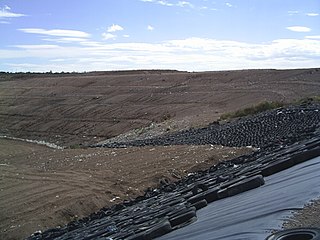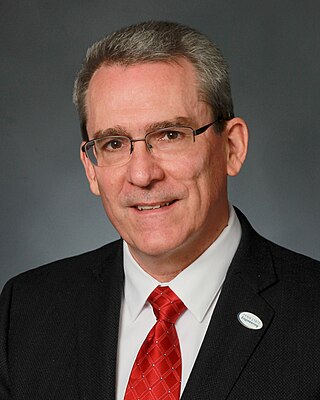
Geotechnical engineering, also known as geotechnics, is the branch of civil engineering concerned with the engineering behavior of earth materials. It uses the principles of soil mechanics and rock mechanics to solve its engineering problems. It also relies on knowledge of geology, hydrology, geophysics, and other related sciences.

Geosynthetics are synthetic products used to stabilize terrain. They are generally polymeric products used to solve civil engineering problems. This includes eight main product categories: geotextiles, geogrids, geonets, geomembranes, geosynthetic clay liners, geofoam, geocells and geocomposites. The polymeric nature of the products makes them suitable for use in the ground where high levels of durability are required. They can also be used in exposed applications. Geosynthetics are available in a wide range of forms and materials. These products have a wide range of applications and are currently used in many civil, geotechnical, transportation, geoenvironmental, hydraulic, and private development applications including roads, airfields, railroads, embankments, retaining structures, reservoirs, canals, dams, erosion control, sediment control, landfill liners, landfill covers, mining, aquaculture and agriculture.

Geotextiles are versatile permeable fabrics that, when used in conjunction with soil, can effectively perform multiple functions, including separation, filtration, reinforcement, protection, and drainage. Typically crafted from polypropylene or polyester, geotextile fabrics are available in two primary forms: woven, which resembles traditional mail bag sacking, and nonwoven, which resembles felt.
A geomembrane is very low permeability synthetic membrane liner or barrier used with any geotechnical engineering related material so as to control fluid migration in a human-made project, structure, or system. Geomembranes are made from relatively thin continuous polymeric sheets, but they can also be made from the impregnation of geotextiles with asphalt, elastomer or polymer sprays, or as multilayered bitumen geocomposites. Continuous polymer sheet geomembranes are, by far, the most common.

A landfill liner, or composite liner, is intended to be a low permeable barrier, which is laid down under engineered landfill sites. Until it deteriorates, the liner retards migration of leachate, and its toxic constituents, into underlying aquifers or nearby rivers from causing potentially irreversible contamination of the local waterway and its sediments.

Cellular confinement systems (CCS)—also known as geocells—are widely used in construction for erosion control, soil stabilization on flat ground and steep slopes, channel protection, and structural reinforcement for load support and earth retention. Typical cellular confinement systems are geosynthetics made with ultrasonically welded high-density polyethylene (HDPE) strips or novel polymeric alloy (NPA)—and expanded on-site to form a honeycomb-like structure—and filled with sand, soil, rock, gravel or concrete.
A geonet is a geosynthetic material similar in structure to a geogrid, consisting of integrally connected parallel sets of ribs overlying similar sets at various angles for in-plane drainage of liquids or gases. Geonets are often laminated with geotextiles on one or both surfaces and are then referred to as drainage geocomposites. They are competitive with other drainage geocomposites having different core configurations.
The Indian Geotechnical Society (IGS) aims at promoting co-operation amongst engineers and scientists for the advancement and dissemination of knowledge in the fields of Soil Mechanics, Foundation Engineering, Soil Dynamics, Engineering Geology, Rock Mechanics, Snow and Ice Mechanics and allied fields and their practical applications. It provides a common forum for academicians, research workers, designers, construction engineers, equipment manufacturers and others interested in geotechnical activity.
The British Geotechnical Association is a learned 'Associated Society' of the Institution of Civil Engineers, based in London, England, and a registered UK charity. It provides a focal point for organisations and individuals interested in geotechnical engineering.

The International Society for Soil Mechanics and Geotechnical Engineering (ISSMGE) is an international professional association, presently based in London, representing engineers, academics and contractors involved in geotechnical engineering. It is a federation of 90 member societies representing 91 countries around the world, which together give it a total of some 21,000 individual members. There are also 43 corporate associates from industry. The current ISSMGE President is Dr Marc Ballouz.
Robert M. Koerner was an American engineer and academic. He was Professor Emeritus at Drexel University and director emeritus of the Geosynthetic Institute. He died on December 1, 2019.
Miguel De La Torre Sobrevilla is a Peruvian engineer and entrepreneur who founded the engineering and consulting company Geoservice Ingeniería back on 1995, he undertook his undergraduate on Civil Engineering at Universidad Nacional de Ingeniería from 1961 to 1965. He is specialist in dam engineering, foundations, slope stability, geotechnical instrumentation and related activities with geotechnical engineering applied to energy projects, irrigation, transportation and mining nationwide.
Ronald Kerry Rowe, OC, BSc, BE, PhD, D.Eng, DSc (hc), FRS, FREng, NAE, FRSC, FCAE, Dist.M.ASCE, FEIC, FIE(Aust), FCSCE, PEng., CPEng. is a Canadian civil engineer of Australian birth, one of the pioneers of geosynthetics.
Geotextiles and Geomembranes is a bimonthly peer-reviewed scientific journal. It is the official journal of the International Geosynthetics Society and published on their behalf by Elsevier. The journal covers all topics relating to geosynthetics, including research, behaviour, performance analysis, testing, design, construction methods, case histories, and field experience.

Jean-Pierre Giroud is a French geotechnical engineer and a pioneer of geosynthetics since 1970. In 1977, he coined the words "geotextile" and "geomembrane", thus initiating the "geo-terminology". He is also a past president of the International Geosynthetics Society, member of the US National Academies, and Chevalier de la Légion d'Honneur.
Jorge G. Zornberg is Professor and Joe J. King Chair in Engineering in the geotechnical engineering program at the University of Texas at Austin. He has over 35 years' experience in geotechnical and geoenvironmental engineering. He is also one of the pioneers of geosynthetics.

T. G. Sitharam is a civil engineer, professor at IISc Bangalore, former director at IIT Guwahati.Currently, he is serving as Chairman of the All India Council for Technical Education,(AICTE) from 1 December 2022 onwards. He is known for his works in the fields of rock mechanics, rock engineering and geotechnical earthquake engineering. He is an elected fellow of Indian Geotechnical Society, Institution of Engineers (India) and American Society of Civil Engineers.

Patrick J Fox, Ph.D., P.E., BC.GE, F.ASCE is an American civil engineer and currently the Dean of the Russ College of Engineering and Technology at Ohio University. His field of expertise is geotechnical and geoenvironmental engineering, with specializations in slope stability, retaining walls, landfills, and settlement. He obtained a Ph.D. in civil and environmental engineering from the University of Wisconsin–Madison in 1992.

Bituminous Geomembrane (BGM) is a type of geomembrane consisting of a reinforcing geotextile to provide mechanical strength and elastomeric bitumen to provide impermeability. Other components such as sand, a glass fleece, and/or a polyester film can be incorporated into the layers of a BGM. Bituminous geomembranes are differentiated from bituminous waterproofing materials used in buildings due in part to their wide roll width, which can exceed 5m, and their substantial thickness of up to 6.0mm.
A double liner is a fluid barrier system that incorporates two impermeable layers separated by a permeable drainage layer also called a leak detection layer. Typically the impermeable layers are made from geomembranes with a permeable layer in between. The uppermost layer is called the primary liner while the lower layer is called the secondary liner. This combination of layers is designed to prevent hydraulic head from building on the secondary liner thereby limiting or preventing any permeation into the secondary liner. Due to the difficulty of constructing a single large scale impermeable layer without any defects, a double liner system is more robust by accounting for leakage through the primary liner. A double liner system is required by the United States EPA for landfill, surface impoundments, and waste piles.










